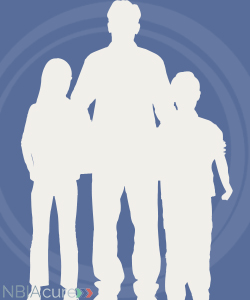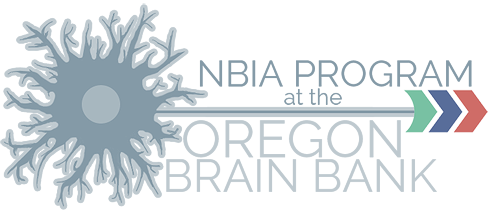It can be a difficult subject to discuss, but our loved ones can continue to help find a cure for NBIA even after death.
In the quest to better understand what causes NBIA, researchers need the opportunity to study brain tissue from affected individuals. Being able to access tissue is instrumental, not only to better understand the disease, but to help find better treatments, too. NBIA researchers utilize this tissue for specialized studies and compare it to tissue from individuals without NBIA. Through these experiments, researchers have been able to identify the presence of abnormal protein deposits in the neurons of individuals with PKAN. This discovery would not have been possible without access to brain tissue.
Even when families know how important tissue can be to research, it is still a challenging choice to make. It might be helpful to know that following donation, families can still have a traditional funeral service with open casket viewing. We partner with the Oregon Brain Bank, which covers all costs related to tissue retrieval so that there is no undue hardship on a family during this arduous time.

A Family’s Perspective
Since donation is such a difficult topic to think about, you may find it helpful to read the stories of NBIA families who have already gone through this process.

The Oregon Brain Bank (OBB) has two missions:
1.) To help families learn the exact diagnosis of a brain disease
2.) To promote brain disease research by providing scientists with autopsy tissue samples to study in their laboratories.
The OBB has partnered with Dr. Susan Hayflick and her team for several years and is committed to supporting NBIA research. The OBB Director, Dr. Randy Woltjer, is a neuropathologist with extensive experience studying brain tissue from donors with NBIA. Dr. Woltjer has published many of these findings and is considered a key member of the OHSU research team. Tissue donations to the OBB will be studied at OHSU. At Dr. Hayflick and Dr. Woltjer’s discretion, some tissues may be shared with other NBIA investigators.
The process of brain donation is relatively simple, and we will work with families at each of these four steps:
1. Registration
If you are considering donation, we encourage you to complete the donor registration form as soon as possible. This is not a binding agreement and you can change your mind about donation at any step in the process. However, it makes the process smoother and less stressful for everyone if we already have this information on file when preparations need to be quickly made for a donation.
If you are interested in registering, please contact Allison Gregory at gregorya@ohsu.edu or 503-494-4344 and she will send you a link to our secure registration form.
2. Early Notification
Very often in cases of NBIA, there are signs that death will occur within a few weeks to days. Please notify us, if possible, as soon as you suspect death will occur soon. This will help us make plans for the donation with the local funeral home, hospital, and/or physicians.
3. Donation
Our program needs to be notified, as soon as is practically possible after the individual with NBIA has died. The sooner the autopsy is performed, the more uses the tissues will have.
The OBB is most easily notified by calling the OHSU hospital operator at (503) 494-8311.
Please ask for Dr. Hayflick to be paged. If you do not receive a response within 15 minutes, ask for Dr. Woltjer to be paged. You can wait on the line for an answer, or leave a call-back number. If there is no response, please call the hospital operator again and ask for the neuropathologist on call to be paged instead, and he or she will refer you to Dr. Woltjer if he is in town, or make other arrangements if he isn’t.
At the time of death, our staff will work with your family to obtain consent for brain autopsy from the legal next of kin (this can be done over the phone). When the body is distant from Portland, we will arrange to have the brain removal done locally. After brain autopsy, the body is returned to the funeral home, and the family can proceed with any other arrangements they have made.
Regardless of any plans made prior to death, the wishes and needs of the family at the time of death will always have priority over those of our program, and family members should not feel “pressured” to take actions that they are not comfortable with at any time.
4. Brain Autopsy
After an extensive evaluation of the brain tissue, Dr. Woltjer will contact the family to discuss the results. If they wish, the family can receive a written report of the complete findings, with a summary letter. Tissue that is not needed for diagnosis is used for NBIA research.
Dr. Woltjer does not charge a professional fee for the diagnostic evaluation, and the family will not receive a bill from OHSU for the laboratory work that is done, which is paid for by voluntary donations. There may be costs associated with transport to/from a funeral home or with the local hospital assisting with tissue removal. The NBIA Program at the Oregon Brain Bank will work with your local providers and cover any costs incurred.
We are happy to answer any and all questions.
Please contact Allison Gregory, MS at gregorya@ohsu.edu or 503-494-4344.
Copyright © 2014 by NBIAcure.org. All rights reserved.